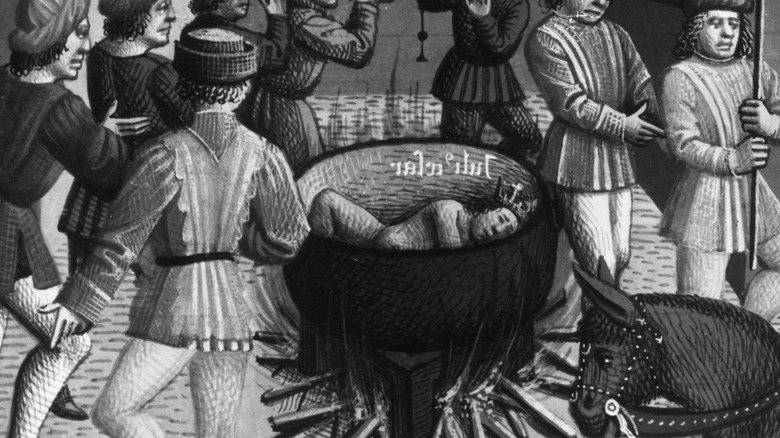What It's Like To Die By Boiling Execution
Being boiled to death sounds like an unimaginable fate. However, according to Britannica, it was a common method of execution in centuries past. Per All That's Interesting, this death was reserved for Christians by the Roman emperor Nero and later on for coin forgers in France and Germany (via History Collection). But it made a comeback in the 16th century thanks to Henry VIII. CrimeBeat states that in 1531, Richard Roose was boiled alive after allegedly poisoning his employer's food. Notably, Henry VIII had only recently passed an act in parliament that made murder by poison an act of treason, most likely due to his phobia of being poisoned.
Roose, a cook, claimed the incident was intended to be a joke as he believed the poison to be laxatives. His gag ended up killing several people in the household of his employer — John Fisher, the Bishop of Rochester (via The Anne Boleyn Files). Thus, Roose was sentenced to death for treason (he did not receive a trial) and was the first man in Britain to be publicly boiled to death. So brutal was this method of execution that it was later banned by Edward VI. Indeed, records from Henry VII's reign indicate that it could take up to two hours for someone to die while being boiled to death.
Being boiled to death is more horrific than imagined
Unlike other methods of execution — such as the guillotine, which is designed to be quick and painless — death by boiling was intended to be a slow and excruciating process. According to All That's Interesting, victims were placed in a large vat of boiling liquid and then cooked. This liquid could be water, oil, wax, or lead, and sometimes, the person would be placed in a cool liquid that was then heated to a boil (per Britannica). This was the preferred method as it takes the body longer to go into shock, thus maximizing the pain. History Collection states that victims would writhe for hours as they were cooked from the outside in.
The body would eventually turn red and blister. Likewise, breathing in the steam would also burn the victims. On a disgusting note, the scent of cooking flesh would permeate the air. Even worse, the person being boiled to death would smell this as they were dying. Although boiling execution is thankfully not used in modern times, death by boiling can still accidentally happen today. In 2016, The Guardian reported that a 23-year-old man died and was dissolved after falling into a hot spring at Yellowstone National Park. At the time his remains were recovered, the water was said to be 212 degrees F — the temperature at which water boils (via ThoughtCo).

